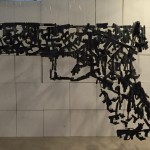Rachmaninoff, seriously
In 1934, when Segei Rachmaninoff started work on his Rhapsody on a Theme of Paganini, he had this to work with:
Nicolò Paganini’s original is the last in a set of 24 Caprices, a compendium of just about everything that it was possible to do on a violin within the limits of the tonal system. Paganini, a towering violin virtuoso, composed the Caprices as his own vehicles between 1802 and 1817. Paganini was among the first musicians to take full advantage of the modern idea of celebrity. High-speed popular presses, a burgeoning middle class, a rapidly developing circuit of public concerts made celebrity possible. The rock ‘n’ roll lifestyle began with Romantic figures such as Paganini; he did, indeed, have groupies, and he did not run away from them.
Like Rachmaninoff’s gloss, the 24th caprice is a theme and variations. You’d think, especially after hearing Hilary Hahn cut through the 11 variations like a force of nature, that Paganini left nothing more to say about this theme. But it turned out to be an object of desire for dozens of composers, including Liszt, Brahms, Busoni, Dallapicola, Skrowaczewski, Liebermann and Symanowski. They all took it for a spin, as did performer-arrangers of all sorts. Versions of the Caprice No. 24 exist for everything from clarinet to electric guitar. (Do click on the guitar link. It’s awesome.)
Rachmaninoff managed to wring 24 variations — one for each Caprice, and that can’t be a coincidence — out of Paganini’s brisk tune. In a leap of imagination, Rachmaninoff supplemented Paganini’s theme with the ancient Dies Irae, from the Latin Requiem mass. It works as both alternate theme and countermelody; the melodies mesh when you play them together.
Those of us who came of age musically in the 1950s, 6os and 70s grew up believing Rachmaninoff (1873-1943) to be a hopeless, intellectually disreputable Romantic relic whose music was fit only for the blue-hairs in the symphony audience. Now that we’ve moved on to a more eclectic musical sensibility, in which innovation and lofty rigor are no longer revered above all other musical values, Rachmaninoff has gained new respect.
Rachmaninoff rarely got credit for the considerable intellectual rigor in his music. Go ahead and swoon when you hear that lush, ardent 18th variation, this weekend, but know that it’s an inversion of the main theme. Inversion — turning the notes upside down, basically — is a favorite brainy trick of the likes of Bach and Schoenberg. Strong feelings flow through Rachmaninoff’s music, but it’s not just about feeling. He understood the architecture and engineering of music, the qualities that engage the mind.
De Waart, who has a particular sympathy for Rachmaninoff, will conduct this weekend. Joyce Yang, brilliant in Rachmaninoff’s daunting Piano Concerto No. 3 last season, will be the soloist in the Paganini variations. The Rhapsody gets played all the time and the ravishing Symphonic Dances, also slated for this weekend, have frequent airings. but the other two works on this MSO program are more rare. The Isle of the Dead dates to 1907, about the same vintage as the Symphony No. 2. Rachmaninoff wrote several versions of his Vocalise, Opus 34 No. 14, from 1912. The most popular is for soprano and piano or soprano and orchestra. The MSO will play the arrangement for orchestra only.
Concert times are 8 p.m. Friday and Saturday and 2:30 p.m. Sunday, Oct. 8-10, at Marcus Center Uihlein Hall. Tickets are $25-$95. Call the MSO, 414-291-7605 or the Marcus box office, 414-273-7206 or visit the mso website.























To really take Rachmaninoff seriously try the extensive dissection of two of these pieces by the BBC 4 program – Discovering Music
Isle of the Dead
http://www.bbc.co.uk/radio3/discoveringmusic/pip/s4ya2/ – 30 minutes
Rhapsody on a Theme of Paganini
http://www.bbc.co.uk/radio3/discoveringmusic/ram/cdmwk09.ram – 43 minutes
(Real Audio streams)